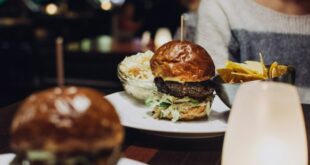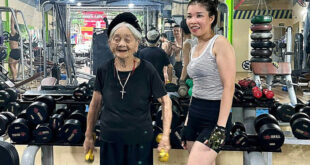After failing the Vietnam university entrance exam, Nguyen Ba Phuoc decided study cooking in Japan, and became the first Southeast Asian given gold prize from the Japanese government’s 2021 Taste of Japan contest.
“My parents gave me VND200 million (around $8,494) so that I could go to Japan,” the 31-year-old from Hanoi’s town of Son Tay recalls.
“But when I arrived I realized that chef training courses there last for at least two years, and require between VND600 and 800 million for both tuition fees and living costs.”
 |
|
Phuoc cuts a tuna for the first time at the Hokkaido restaurant HanaOugi in 2019. Photo courtesy of Phuoc |
He thought about giving up since his family didn’t have that kind of money.
But when he was his most hopeless point, he happened by chance to meet the principal of the Hokuto Bunka Academy’s International School of Culinary Arts.
The principal was impressed by the young man and said his prestigious Japanese school would accept Phuoc if he could pass an essay and interview process.
Phuoc wrote about how cooking skills ran in his family, how he started learning to cook from age 7, and how he was determined to learn about the “core” of the Japanese culinary art.
He soon became the first Vietnamese offered a full scholarship to the school.
The course Phuoc enrolled in was taught wholly in Japanese, and it included modules about Japanese cuisine cooking, Japanese constitution, Japanese food safety and hygiene, culinary culture, culinary theory, and nutrition. He spent all of his time studying, but still he failed four out of a total of 16 courses in his first term.
Falling to the bottom of the student list was not an good feeling. And then Phuoc was informed by the principal that his scholarship would be terminated if his performance didn’t improve.
“There can only be two reasons [for your bad performances],” said the principal. “Either you didn’t put in enough effort, or your efforts were spent in a wrong way.”
After reflecting briefly, Phuoc realized that he’d put his efforts in the wrong places.
He started to change his approach.
During the next term, instead of focusing on academic studies, he became more active in interacting and communicating with other classmates. He learned about their cultures and taught them how to cook Vietnamese cuisine in exchange.
His hard work paid off and his academic performance started improving. He graduated with some of his class’s highest marks in early-2018 and was offered a position at HanaOugi, a kaiseki (traditional multi-course Japanese dinner) restaurant that has served the Emperor of Japan twice.
Phuoc says the pressure of working is ten times that of studying. His professional working environment requires him to pay attention to the smallest details, and he was shouted at a lot when he first started. He had to work as many as 16 hours a day on public holidays.
People who started working at the restaurant at the same time as Phuoc gave up one after another, and after six months, Phuoc and only a single friend of his were the last two who survived.
But Phuoc was not satisfied with the small tasks he had been given, like cleaning and cutting vegetables, or kitchen tidying. He wanted to be more specialized.
“I wondered if those small tasks were worth exchanging my youth for,” he says.
Despite some misgivings, Phuoc still got up early every morning to work at the restaurant from 5 a.m. till 10 p.m. His enthusiasm and ingenuity eventually won over the hearts of experienced chefs working there.
“Finally they started asking me to make onsen eggs, and then decorate some of the bigger dishes, and then finally, prepare them,” Phuoc says.
 |
|
Phuoc prepares an original dish made from seaweed and katsuobushi (dried tuna slices) at a Japanese cuisine event in Hanoi in 2019. Photo courtesy of Phuoc |
Phuoc soon set his eyes on the prestigious art of tuna cutting, a highly specialized craft in Japanese cuisine. Being left-handed, he had to practice extra hard because the Japanese style of cutting fish requires chefs to use their right hands. He started using his right hand to brush his teeth, and then to cut food.
“I almost cut my fingers many times, but I was able to improve my eye for detail through this practice,” he says.
Before trying his hand at tuna cutting, Phuoc spent a lot of time observing experienced chefs perform the task. He asked them to help clarify what he wasn’t clear, and he practiced the specific slices with smaller fish before moving on to tuna.
He begged the head chef for a chance to cut the fish many times, but was rejected because he was told that chefs should be over 30 and have at least five years of experience working to be granted a chance to cut the tuna.
But his determination eventually won him a chance. He was approved in 2019 to try what he had always wanted to do.
He performed the task for the first time ever in front of around 200 guests and experienced chefs.
“I made a lot of mistakes,” Phuoc admits. “Customers didn’t realize it, but my mentors spotted them right away.”
But it didn’t bother him during the performance. As soon as he’d finished cutting the giant fish into tiny pieces of sashimi, he ran to the back of the kitchen to have a happy laugh by himself in a shirt soaked in his own nervous sweat.
But unfortunately, Phuoc left HanaOugi and hit the big city just in time for the outbreak of Covid-19 and the crippling of the global restaurant industry by its subsequent international lockdown.
Phuoc wasn’t able to find work in Japan’s capital city, also the capital of cuisine and sushi.
“[During lockdown] there was a time I took out my sashimi at home,” he recalls. “I burst into tears while sharpening it, wishing I could be standing in a restaurant kitchen doing even the smallest task.”
With his experience at HanaOugi, Phuoc eventually managed to find a position at a sushi restaurant after two months of unemployment. It then took him another three months to become the restaurant’s chef manager.
His career has bloomed since then, and he was offered a job at the renowned Yoshimura restaurant, where he became a student of the eatery’s famous head chef Hirokazu Tomisawa.
“I knew he [Phuoc] would succeed as a chef the moment he stepped into my kitchen,” Hirokazu says.
 |
|
Phuoc preparing for a dish under Hirokazu’s instructions at Yoshimura. Photo courtesy of Phuoc |
Phuoc is grateful for many things he has learned from the Japanese mater, who taught him that every chef has to serve their customers with “value, consideration, and stories,” in addition to tasty dishes.
Phuoc says Hirokazu taught him to cut each piece of sushi exactly 3-centimeters as that fits most comfortably in the average customer’s mouth. Phuoc says small, detailed teachings like this are what showed him how respectful and thoughtful a good chef should be towards his customers.
Hirokazu then recommended Phuoc compete in the Japanese government’s 2021 Taste of Japan contest. For the contest, Phuoc prepared a total of 17 extremely simple and exceedingly complicated dishes for a wide-ranging a shokado bento box that made him the first Southeast Asian ever given the event’s golden prize.
Now he dedicates a lot of his time to helping others. He guides official Vietnamese delegations in Japan, and has also helped 20 students obtain scholarships for culinary studies in Japan.
Reflecting on his journey, Phuoc says the more he learned and achieved, the more determined he was to bring everything he’s gained back home. That’s why earlier this year he returned to Hanoi with plans to open his own Japanese restaurant in the capital soon.
- Reduce Hair Loss with PURA D’OR Gold Label Shampoo
- Castor Oil Has Made a “Huge” Difference With Hair and Brow Growth
- Excessive hair loss in men: Signs of illness that cannot be subjective
- Dịch Vụ SEO Website ở Los Angeles, CA: đưa trang web doanh nghiệp bạn lên top Google
- Nails Salon Sierra Madre
 VnExpress News The News Gateway of Vietnam
VnExpress News The News Gateway of Vietnam





